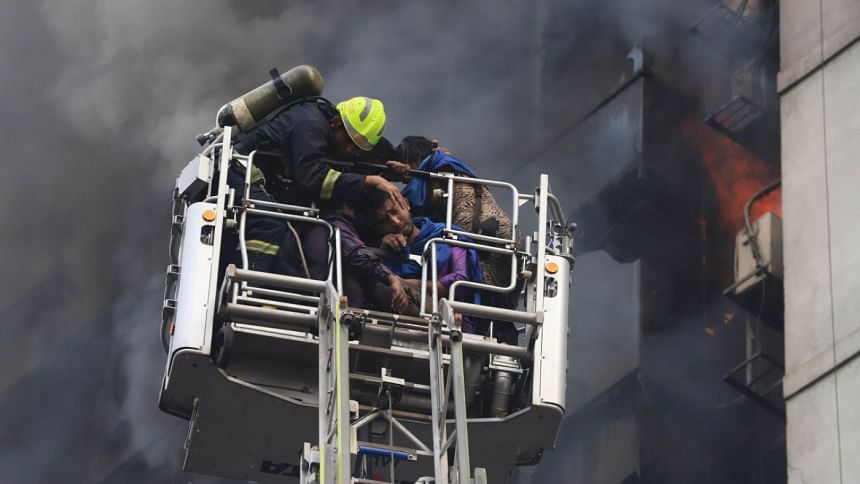High-rises in The Capital: Concern over sloppy fire safety measures


Most high-rise buildings in Dhaka lack fire safety measures, which can cause high causalities in case of a fire, experts said.
Currently, there are about 4,000 high-rises in Dhaka, mostly in the new parts and the posh areas of the capital.
Thursday's fire at the 22-storey FR Tower, an upmarket commercial building in Banani, shows how vulnerable the new Dhaka is.
Most high-rise buildings here have been built in violation of the original design. In the original design, the owners show proper fire safety measures, but during construction, they deviate from the plan, authorities and experts said.
“We conducted a survey in 2011 on high-rise buildings in Dhaka. We found that 90 percent of the buildings did not comply with the fire safety measures,” Prof Mehedi Ahmed Ansari of Buet told The Daily Star.
Of the 53 high-rises surveyed, only two hospitals and two hotels fully complied with fire safety measures.
Buet did not do any such study after 2011.
Fire service treats buildings beyond six-storey as high-rises.
In the last one year, about 680 designs for high-rises were submitted to the Rajdhani Unnayan Kartripakkha (Rajuk). About half of them were rejected on fire safety grounds as well as for violation of the building code.
Contacted, Rajuk Chairman Abdur Rahman said most high-rise buildings were built before the passage of fire safety rules in 2008.
“Yes, many buildings were constructed without fire safety measures. For example, almost all buildings on Kemal Ataturk Avenue in Banani were built before 2008 when the fire safety rules were incorporated in the Fire Prevention and Extinguishing Rules 2003. I joined Rajuk in 2015. And I can say that since then not a single building was allowed to be built without fire safety measures,” he said.
There are three safety hazards in a high-rise -- structural, electrical and fire. To ensure fire safety, a high-rise building requires an investment of around Tk 1.5 crore and needs regular maintenance, experts said.
In any high-rise, every floor must have a mini fire station -- water reservoir, fire extinguisher, hose reel, sand buckets and a refuge area for every five floors with an open space where fire or smoke cannot enter, said former fire service chief Brig Gen (retd) Abu Nayeem Md Shahidullah.
“Ensuring fire safety requires a lot of money, which is why building owners or developers are often reluctant to invest,” he noted.
While taking permission, owners of high-rise buildings show fire safety measures in their plan, he said.
“But a high-rise building takes three to five years to be built and the fire department cannot often follow up on the fire safety issue. Building owners take advantage of this,” he noted.
At FR Tower, for example, fire spread to other floors. But if the building was constructed in line with the national building code, the fire would not have spread to other floors.
“It indicates that the building has structural flaws. Primarily, it is assumed that the fire originated from an electrical short circuit. This means there were faults with the electrical wiring in the building,” he said.
Architect and urban planner Iqbal Habib said in high-rise buildings, fire safety issue is more stringent compared with those with two to six floors.
“It is not about old Dhaka or new Dhaka. Entire Dhaka is in a severe danger as most buildings have been constructed flouting building codes, and there is no one to oversee these,” he said.
Renowned urban planning expert Nazrul Islam, also chairman of the Centre for Urban Studies, echoed his views.
“If the government does not take strict actions, the situation will not improve,” he said.
Toufiq M Seraj, founder and managing director of Sheltech, a real-estate developer, said fire safety issue was not mandatory till 2008. So many buildings constructed before 2008 may not have fire safety measures.
“But all the buildings constructed by reputed organisations after 2008 comply with the fire safety rules. Now fire safety measures in those buildings can be ensured and strengthened through corrective measures,” he said.
The most important thing is fire safety management, such as keeping the emergency exits clear and open at all time, he added.
Brig Gen Sajjad Hussain, director general of fire service, said most buildings in the upscale of Dhaka were constructed without leaving any space. Even the car parks are occupied by shops.
Everybody is talking about strengthening the fire service but the way such buildings are being built is very alarming, he said.
“Time has come to enforce the law firmly. The government should strictly monitor the fire safety measures at all high-rise buildings,” he said.

 For all latest news, follow The Daily Star's Google News channel.
For all latest news, follow The Daily Star's Google News channel. 








Comments